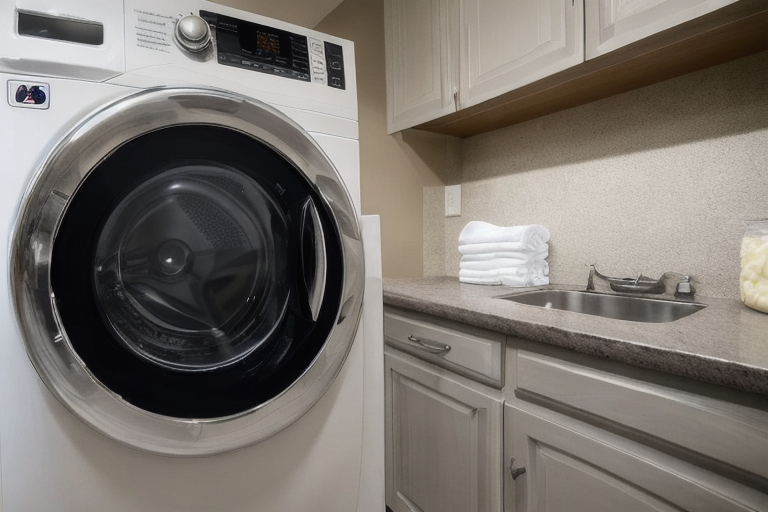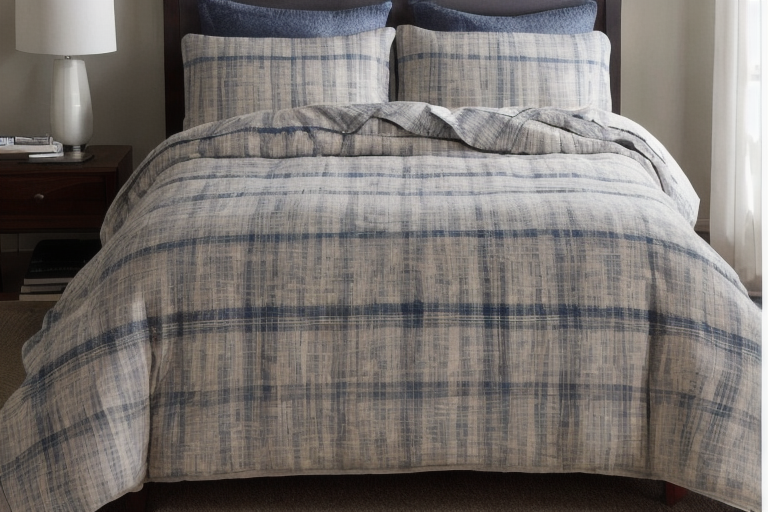Do you love snuggling under the warmth and softness of a down-filled comforter? These cozy bed coverings can last for years when properly cared for. But washing down requires special considerations to prevent damage. Get ready to learn the ins and outs of safely and effectively laundering down comforters at home.
Why Choose Down?
Before we dive into cleaning, let’s review why down-filled bedding makes such a dreamy covering in the first place:
Benefits of down comforters:
- Ultimate comfort and warmth – Down provides unbeatable softness and insulation. The clusters trap air to keep you cozy in cold weather but still breathe well during summer.
- Long-lasting when cared for – With proper maintenance like routine washing, quality down can last over 10 years. Proper storage also prevents dust and dirt buildup.
- Lightweight and lofty – Down fills add warmth without weight, puffing up to create a plush, billowy effect.
- Natural and sustainable – Responsibly-sourced down and feathers come from ducks and geese as a byproduct of the food industry, not live plucking.
Know Before You Wash

While machine washing down comforters at home is possible, it does require some prep work and care to do it right:
Gather Your Materials
- Large-capacity washing machine
- Gentle/delicate detergent
- Fabric protector spray (optional)
- Tennis balls
- Extra large dryer (or outdoor clothesline)
Read the Care Label
Check the sewn-in tag to see what method your comforter manufacturer recommends – machine wash, dry clean only or hand wash.
Follow any special guidelines like water temperature or dryer settings.
Inspect for Stains
Treat any visible stains by spot cleaning with an enzymatic cleaner or non-chlorine bleach before laundering. This prevents setting them deeper into the fabric.
Weighing Your Options
How you clean your down comforter depends on its size, fill material, and your available equipment at home. Consider:
| Cleaning Method | When It’s Best |
|---|---|
| At-home machine wash | For down comforters under 20 lbs that have a machine wash care label. Requires large size home washer and dryer. Most budget-friendly option when done properly. |
| Professional laundering | For comforters over 20 lbs or labeled dry clean only. Laundromats have commercial equipment to handle heavy bedding. Costs $25-$50 per wash. |
| Hand washing | Gentle option for small down throws or delicate comforters. Requires lots of space, effort and drying time. |
“Hand washing thinner or delicate down comforters in the bathtub with mild soap allows thorough cleaning while being gentle on materials,” says Maria Carter, textiles expert.
Choosing an at-home machine wash cycle for heavy comforters requires an extra-large washer. Test out your equipment before attempting.
Prep Work: Fluff, Treat, and Fill
To make sure your comforter washes effectively, do this easy prep:
1. Fluff – Shake out and gently “massage” clumped filling to evenly redistribute down before washing.
2. Spot treat stains – Lightly spritz soiled spots with a 50/50 vinegar and water mixture. Let soak 5 minutes before laundering.
3. Check washer capacity – Add a few towels if needed to reduce empty space so comforter can soak and move freely during cycle.
Choose Wash/Dry Cycles Carefully
The wash cycle for a whole down comforter requires:
- Large-capacity washer – Around 5 cubic feet for a queen size
- Gentle/delicate cycle
- Cool/cold temp for wash and rinse
- Mild liquid detergent, no bleach
Be sure to:
- Leave room for the comforter to move freely
- Add a second rinse cycle to fully remove soap
When drying, use:
- Low Heat setting (or no heat – air dry)
- Wool or delicate dryer balls to fluff
- Extra drying time, re-fluffing halfway
Adding two clean tennis balls to the dryer will also help break up clumps!
Drying thoroughly is key to avoid mold and mildew. A damp comforter can ruin down clumping it into unusable mattes.
“Take extra care to fully dry a comforter, re-fluffing half way through and allowing extra time. Stick your nose deep inside the comforter – if you detect any dampness, it needs more drying time,” advises Sara Dunn, cleaning expert.
Special Considerations by Down Fill Types
Not all down is the same when it comes to wash care:
| Down Type | Washing Tips |
|---|---|
| Goose Down | Very resilient; higher heat tolerance for washing and drying |
| Duck Down | Gentler wash and dry cycles needed |
| Feather Down | Most delicate; hand wash or dry clean recommended |
Alternative down fills made from synthetic fibers can typically be machine washed and dried on regular settings. Always defer to manufacturer’s care instructions.
Proper Storage = Longer Life

Keep your comforter in the best condition between uses:
- Allow to fully air out before folding
- Store loose or lightly rolled in breathable bag
- Never compress into tight spaces long-term
- Wash twice yearly at minimum
Improper storage leads to dust mites, odor, mold, and clumping shortening usable life.
“I recommend washing down comforters a minimum of twice yearly – once before warmer months to store clean over summer, and again before cozying up for the winter,” says Lynne Carter, organizational expert and author of The Life-Changing Magic of Tidy Bedding.
Common Laundry Pitfalls
While washing down at home is possible, there are few common mistakes that can spell disaster:
| Issue | How to Avoid |
|---|---|
| Clumping/Matting | Use dryer balls and re-fluff mid-cycle to loft fill |
| Musty Smell | Dry completely and allow to air out before storage |
| Shrinkage | Skip the heat! Use cool/cold water and low or no heat drying |
| Lint Build Up | Add distilled white vinegar to the rinse cycle |
| Stubborn Stains | Pretreat stains before washing with enzymatic cleaner |
“If your down comforter comes out of the wash with stubborn clumps or matting, don’t panic! Use clean tennis balls to fluff the filling again in the dryer on air only mode,” advises Molly Chen, laundry expert.
When to Send Out for Cleaning
While convenient and cost-effective, home washing does have size and load limitations. Some instances when professional laundering is best:
- Oversized or heavy comforters – Generally those over 20 lbs
- Filled with delicate downs requiring special handling
- Have developed stubborn, deep stains
- Care labels specify “Dry Clean Only”
- Don’t have an adequately sized washer/dryer
Look for laundromats with large-scale machines designed for bedding and other bulky items if home equipment can’t accommodate.
Caring properly for your down-filled favorites means they’ll provide years of cozy comfort. Follow these tips to keep your bedding fluffy, fresh and clean all year through!
Frequently Asked Questions
What temperature water should I use to wash my down comforter?
Use cool or cold water on the gentle cycle setting to machine wash down comforters. Hot water can damage or shrink delicate fabrics. Stick to temperatures under 80°F if possible.
Can I put a wet down comforter in the dryer?
Never put a damp or wet down comforter directly into the dryer! Always make sure comforters are completely air dried before using the dryer to fluff and fully dry out the down fill. Load wet down into a hot dryer can cause permanent clumping.
How often should you wash a down comforter?
We recommend washing down comforters at home twice per year at minimum. Wash them before storing for summer and again before using for winter. More frequent washing may be needed if you sweat excessively or eat/drink in bed. Use a duvet cover to protect your comforter between washings.
Why does my down comforter have a smell after washing?
A musty or sour odor after washing signals your comforter did not dry thoroughly. Re-wash using an extra rinse cycle and dry completely on low heat, re-fluffing several times and checking internal fill for any remaining moisture. Be sure fill is fully dry before taking out of the dryer or clumping and odor can occur.
Can I use bleach when washing my down comforter?
Never use harsh chlorine bleach, oxygen bleach or fabric softener to wash down! Instead opt for non-chlorine bleach or color-safe bleach alternatives that are gentle enough for delicate fabrics if trying to remove stubborn stains. Rinse extremely thoroughly after pretreating spots.
How can I get clumps out of my down comforter?
If your freshly washed comforter comes out with stubborn clumps or uneven spots, rewash and dry with tennis balls added to help redistribute and separate the fill. You can also massage clumpy areas gently by hand if caught right after drying to try loosening stuck down clusters without damaging fibers before re-drying fully.
When should I take my down comforter to the dry cleaner instead?
Some instances calling for professional dry cleaning instead of home washing are: comforters over 20 pounds weight, labels specifying “dry clean only”, extremely delicate feather fills, valuable heirloom quality comforters, and bedding with many intricate details not suitable for machine washing and drying. Handmade wool, silk, or antique cotton comforters should also be professionally laundered.








